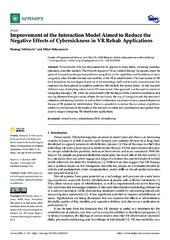Please use this identifier to cite or link to this item:
https://rfos.fon.bg.ac.rs/handle/123456789/2201Full metadata record
| DC Field | Value | Language |
|---|---|---|
| dc.creator | Veličković, Predrag | |
| dc.creator | Milovanović, Miloš | |
| dc.date.accessioned | 2023-05-12T11:35:38Z | - |
| dc.date.available | 2023-05-12T11:35:38Z | - |
| dc.date.issued | 2021 | |
| dc.identifier.issn | 1424-8220 | |
| dc.identifier.uri | https://rfos.fon.bg.ac.rs/handle/123456789/2201 | - |
| dc.description.abstract | Virtual reality (VR) has the potential to be applied in many fields, including medicine, education, scientific research. The e-health impact of VR on medical therapy for people cannot be ignored, but participants reported problems using them, as the capabilities and limitations of users can greatly affect the effectiveness and usability of the VR in rehabilitation. Previous studies of VR have focused on the development and use of the technology itself, and it is only in recent years that emphasis has been placed on usability problems that include the human factor. In this research, different ways of adapting interaction in VR were tested. One approach was focused on means of navigating through a VR, while the second dealt with the impact of the amount of animation and moving elements through a series of tests. In conclusion, the way of navigation and the amount of animation and moving elements, as well as their combination, are proven to have a great influence on the use of VR systems for rehabilitation. There is a possibility to reduce the occurrence of problems related to cybersickness if the results of this research are taken into consideration and applied from an early stage of designing VR rehabilitation applications. | en |
| dc.publisher | MDPI, Basel | |
| dc.relation | info:eu-repo/grantAgreement/ScienceFundRS/AI/6524219/RS// | |
| dc.rights | openAccess | |
| dc.rights.uri | https://creativecommons.org/licenses/by/4.0/ | |
| dc.source | Sensors | |
| dc.subject | virtual reality | en |
| dc.subject | rehabilitation | en |
| dc.subject | HCI | en |
| dc.subject | cybersickness | en |
| dc.title | Improvement of the Interaction Model Aimed to Reduce the Negative Effects of Cybersickness in VR Rehab Applications | en |
| dc.type | article | |
| dc.rights.license | BY | |
| dc.citation.issue | 2 | |
| dc.citation.other | 21(2): - | |
| dc.citation.rank | M21 | |
| dc.citation.volume | 21 | |
| dc.identifier.doi | 10.3390/s21020321 | |
| dc.identifier.fulltext | http://prototype2.rcub.bg.ac.rs/bitstream/id/762/2197.pdf | |
| dc.identifier.pmid | 33418838 | |
| dc.identifier.rcub | conv_2445 | |
| dc.identifier.scopus | 2-s2.0-85099087453 | |
| dc.identifier.wos | 000611695900001 | |
| dc.type.version | publishedVersion | |
| item.cerifentitytype | Publications | - |
| item.fulltext | With Fulltext | - |
| item.grantfulltext | open | - |
| item.openairetype | article | - |
| item.openairecristype | http://purl.org/coar/resource_type/c_18cf | - |
| Appears in Collections: | Radovi istraživača / Researchers’ publications | |
This item is licensed under a Creative Commons License


